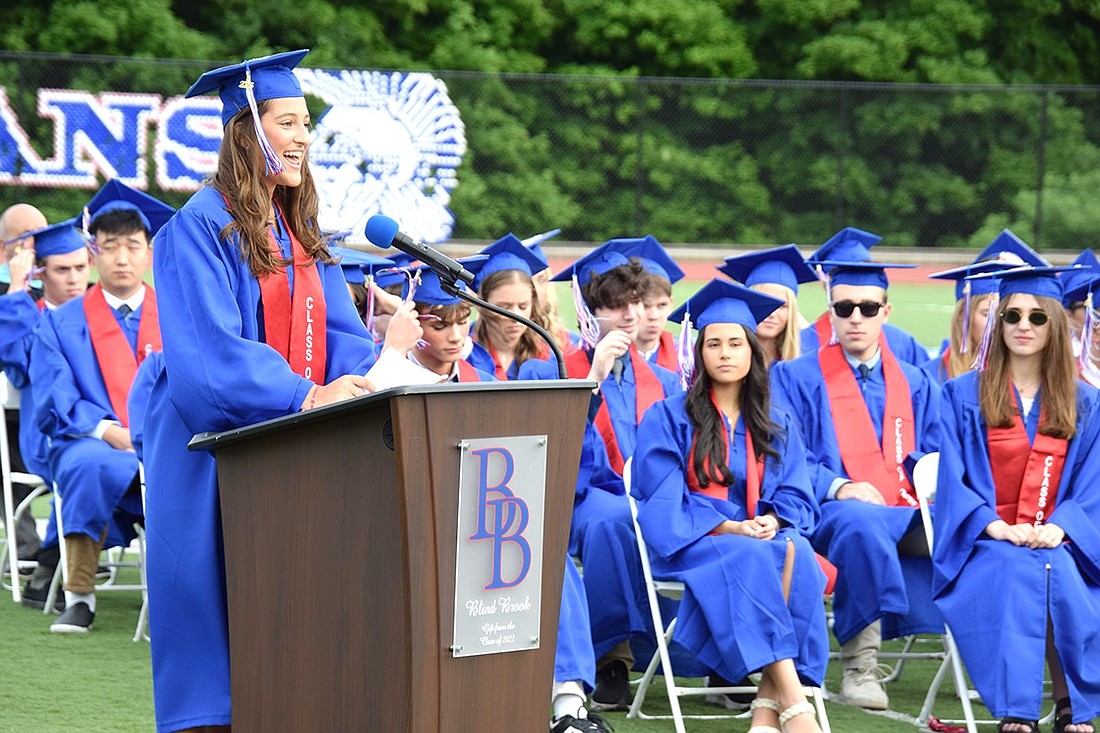Defining the ideal graduate
October 12, 2023 at 2:02 a.m.
The Blind Brook School District is well-regarded as a high-achieving entity. But what does that mean? What does a high school graduate look like?
During the 2021-2022 school year, members of the Blind Brook School District community came together to develop a strategic plan to be implemented until 2027. A large part of that plan was crafting an official “Vision of the Graduate” (VOG).
The VOG is a list of skills and dispositions the school district believes a graduate of Blind Brook High School should have by the time they’re moving on to the next chapter of their lives. It’s a decision-making tool that has often been referenced at Board of Education meetings over the last few years, but at the board’s session on Sept. 30, the administration defined what those qualities are to the public.
The list, made up of five skills and five dispositions, was created by a committee of 18 people, according to Superintendent of Schools Dr. Colin Byrne. Comprised of two Board of Education members as well as several teachers, administrators, parents and students, they spent several months narrowing down their idea of what a graduate should be like.
“It took a couple of meetings,” Byrne said, as the group had to take many factors into account. According to the detailed report, which is available on the school district website, the district polled parents and staff on what traits students would need most to be prepared for life outside of school.
“Our process was to gather data first, then brainstorm,” Byrne said. Ultimately, over 270 parents provided more than 370 suggestions, he added, which they then narrowed down to just 10.
The final five skills that were chosen are: being a written and spoken communicator, a critical and creative thinker, a problem solver, being socially and emotionally aware, and being organized and productive.
Byrne said that students will be able to demonstrate these abilities through their work and performance in school. However, the other half of the vision is a bit more nuanced.
The dispositions that were selected are: having integrity and respect, being intellectually curious, maintaining a growth mindset, being emotionally intelligent, and being independent and efficacious.
“Dispositions are more personality based,” Byrne said, “so we came up with indicators of how someone could show that behavior.”
With the vision set in place, the committee moved on to the next phase of the planning process. “Our next step is to look at those skills and dispositions,” the superintendent said, “through a building-wide lens.”
The overall goal of the district is for students to reach maturation in those qualities by the time they’re in grade 12, but it’s not something that exclusively happens in high school.
“Where should a student entering middle school be on that continuum? A student going into ninth grade?” Byrne posed—suggesting those are the questions the district must answer next in order to create a more specific guideline for each building.
Once those have been finalized, the district will use them to help navigate students towards success.
“We’re going to be working on aligning our curriculum writing process,” he said on how the VOG will be used by the district, “as well as how they take into account the Vision of the Graduate and also the definition of deep learning.”
Deep learning, and defining its nature, was also a part of the planning committee’s efforts.
Eight environmental factors comprising the Definition of Deep Learning (DODL) are what Byrne and his team deemed as essential to making sure that students will be able to achieve the VOG.
“People may have different ideas as to what (deep learning) means,” he said. “That’s why one of our tasks was to identify what the definition is.”
Those elements are listed as:
*Having the right tools and equipment and resources
*Enjoyment of the process of learning
*Having the right support system, role models and mentors
*Environment for growth—encouragement—mindset for growth
*Meaningful student engagement with student voice
*Opportunity for repeated practice
*Perseverance through failure
*Intrinsic motivation
“These are the things that, when you see it in a classroom, it shows that deep learning is happening,” Byrne said.
This definition will also be evaluated from building to building, he explained, determining “What does it mean for a student to be engaged at fourth grade versus sixth grade versus eighth?”
As with the VOG, more conversations will be held internally about what the district would like to see from each grade level.
While both the VOG and DODL will be used to make decisions on how curriculum will be developed on a district-wide basis, the more immediate steps are to communicate what both are to the community. At the Blind Brook Board of Education meeting on Sept. 20, Byrne stated that the district will be promoting both the VOG and DODL by creating signs and videos to notify the community about the direction in which the district is going.
As it stands, students in the Blind Brook School District now have a clearer picture of what they should be capable of by the time they graduate.




Comments:
You must login to comment.